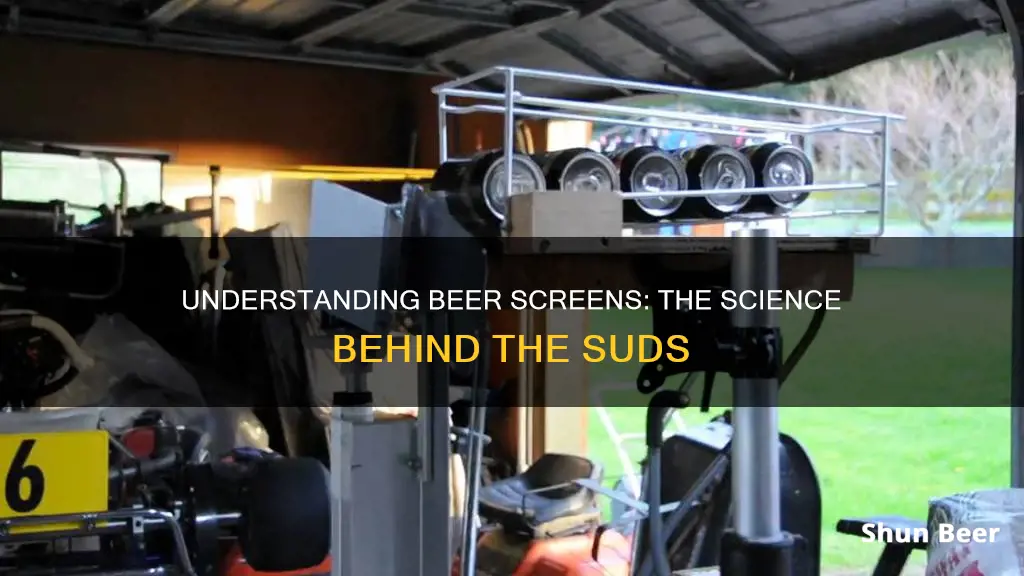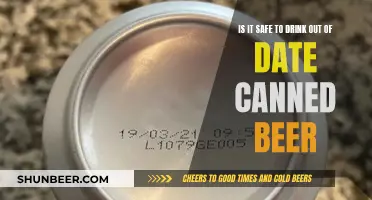
Beer screens are digital menus that display the beers available on tap. They are usually displayed on a TV screen and can be updated in real-time as new beers are introduced or old ones are tapped out. Some beer screens also provide additional information about each beer, such as tasting notes, ABV, and IBU. Beer screens offer a convenient and modern way to browse the selection of beers available and can enhance the customer experience by reducing waiting times and providing easy access to information. In addition, they can be integrated with point-of-sale systems, allowing for automatic updates to inventory and pricing changes during promotions. While some people prefer traditional chalkboards or printed menus, beer screens offer dynamic and interactive options for displaying beer menus, especially in establishments with frequently rotating taps.
| Characteristics | Values |
|---|---|
| Purpose | To save money by replacing human servers with pour-your-own electronic taps |
| Mechanism | Customers insert a card, touch a screen, and pour a glass of self-serve beer |
| Benefits | Faster pouring, hands-free hygiene, novel marketing opportunities, and reduced waste |
| Drawbacks | High upfront costs, require specially made cups, and produce more waste than traditional keg dispensers |
What You'll Learn

Self-serve beer taps
The self-serve beer taps usually consist of an ordinary beer tap, with additional components to enable self-service. These include a flow controller, a screen, and an RFID card reader or a contactless bank card reader. The flow controller, equipped with a flow meter and valve, tracks how much beer has been dispensed and controls access to the tap. The RFID card reader or contactless bank card reader allows customers to activate the tap by linking their card to the table. Customers can load funds onto their RFID cards, which are deducted when beer is poured, or their spend can be tracked and paid for later.
The screen on the self-service tap informs customers about the amount poured, their remaining balance, and the cost. In some cases, the screen may also offer additional services such as food ordering or music selection. The screen can also be utilised by businesses to display promotional videos and advertisements.
The self-serve beer tap system offers several advantages to both customers and business owners. Customers benefit from reduced waiting times and the freedom to pour as much or as little beer as they want. They can also sample different drinks before finding their favourite, leading to increased beverage consumption and overall spend. For business owners, self-pour taps boost profits, increase efficiency, decrease waste, maximise usable space, and reduce operational costs. The system also allows businesses to gather valuable data and gain insights into customer behaviour and preferences.
Overall, self-serve beer taps provide a unique and engaging experience for customers, encouraging repeat visits and positive word-of-mouth recommendations.
Beer Left Outside: Still Refreshing or a Disaster?
You may want to see also

Bottom-up draft pouring
The bottom-up draft pouring system relies on magnets to function. Special cups with a hole in the bottom and a metal magnetic ring to seal their underside are required for this system. When these glasses are placed on the dispenser platform, the magnets are lifted, allowing the beer to flow upward without leaking. This seemingly gravity-defying feat might appear like magic to those witnessing it for the first time.
The main benefit of bottom-up draft pouring is speed. It takes approximately ten seconds to pour a pint using traditional methods, and servers must constantly monitor the pour to prevent overflow. In contrast, a single server with four taps can fill up to 44 pints per minute using the bottom-up system. This increased efficiency can significantly reduce waiting times for customers and allow staff to focus on other tasks, such as taking card payments, cleaning surfaces, and preparing other drinks.
In addition to speed and efficiency, bottom-up draft systems offer improved hygiene. Traditional pouring methods involve inserting a nozzle into each new glass, which can be unhygienic due to residual beer from previous pours. Bottom-up systems eliminate this issue by dispensing beer from the bottom up, removing the need for a long spout or nozzle.
While bottom-up draft pouring systems offer significant advantages, they also come with higher upfront costs. A typical single-keg dispenser costs around $1,500, while a bottom-up dispenser costs closer to $4,000. Additionally, these systems require specially made, magnet-driven cups, glasses, and pitchers, which generate more waste than traditional dispensers. However, the single-use magnets that power these cups can be customised with branding and promotional offers, providing portable advertising that may spark conversations about the bar.
Tanning with Beer: Does It Work?
You may want to see also

Digital beer menus
There are several companies offering digital beer menu services, such as Taplist.io, DigitalPour, and Pourwall. These services allow businesses to display their menus on HD TV screens, often in real-time, with changes made from a computer, tablet, or smartphone. This means that when a keg runs out, or a new beer is added, the menu can be updated instantly, providing an accurate, up-to-date list of available beers.
These digital menus can also be customized to match a brand's style and can include images, logos, and other graphics. They can be displayed on various devices, including smartphones, tablets, and TVs, and can be integrated with Point-of-Sale (POS) systems, making them a dynamic and flexible option for businesses.
In addition to convenience and aesthetics, digital beer menus can also provide valuable data and analytics. For example, DigitalPour offers interactive reports that give businesses insight into customer preferences, average time a beer has been on tap, average income generated, and average profits. This information can be used to optimize inventory and improve profitability.
The use of digital menus can also help to reduce costs and save time, as they eliminate the need for manual menu updates and can automatically adjust pricing during happy hour or other promotions.
Shout Stain Remover: Beer Stain Solution?
You may want to see also

Tap handles
Taphandles is a company that specialises in the design and production of custom tap handles, towers, and other dispense marketing tools for beverage brands. With 25 years of experience, Taphandles has become a leader in the industry, offering fully integrated design, engineering, and manufacturing services. They work with beverage companies of all sizes to create functional and eye-catching products that drive brand growth and create memorable experiences for consumers.
The company's design studio is recognised for its creative solutions, developing design concepts into photo-realistic product renderings ready for prototyping, engineering, and production. Taphandles' products are known for their high quality and speed to market, with custom tap handles and towers for beverages of all kinds, including beer, cider, wine, and spirits. The company has worked with various notable brands, including Hendrick's Gin, Cupcake Vineyards, and AleSmith Brewing Company, to create unique and brand-driven designs.
One of the key benefits of partnering with Taphandles is their ability to manage and control each stage of the process in-house, from design to manufacturing. This integrated approach ensures that the final product aligns with the brand's strategic objectives and helps to achieve their business goals. Taphandles' custom tap handles are designed to engage consumers and drive sales, increasing brand visibility and attracting new customers.
In addition to their custom products, Taphandles also offers a ready-made collection with options to suit different budgets and quantities. Their products feature a range of materials, including hand-decorated sculpted urethane, anodized metal hardware, wood, and machined metal. The company's attention to detail and dedication to cultivating long-lasting relationships have made them a trusted partner for over 7,000 brands worldwide.
With operations in Europe and Asia, Taphandles has established itself as a global leader in the tap handle industry, delivering innovative and effective marketing solutions for beverage brands. Their expertise in dispense marketing has helped countless companies enhance their brand presence and create memorable experiences for their consumers at the point of dispense.
Centrifugal Force: Spinning Beer to Perfection
You may want to see also

Tap displays
Static tap displays often consist of a chalkboard or a printed menu placed near the taps, listing the available beers and sometimes their prices. This traditional approach has been used for years and can be effective in a smaller establishment with a limited beer selection. It provides a simple, straightforward presentation of the beer options, which can be easily updated by staff.
On the other hand, digital tap displays offer a more modern and dynamic approach. These displays typically involve screens mounted near the taps or integrated into the tap system itself. The screens can showcase a variety of information, such as beer names, prices, alcohol content, and even promotional content. One of the main benefits of digital displays is their ability to be updated in real time. For example, if a keg runs out, the display can immediately reflect that change, providing an accurate representation of the available beers.
Digital tap displays also offer interactivity, allowing customers to make informed choices. Some displays may provide detailed descriptions of each beer, including tasting notes, ingredients, and even food pairing suggestions. Patrons can use these displays to explore different options and make selections that align with their preferences. Additionally, digital displays can support multiple languages, making the beer selection process more inclusive for a diverse customer base.
Furthermore, digital tap displays can be integrated with point-of-sale systems, providing valuable data insights. For instance, the system can track which beers are most popular, monitor inventory levels, and even adjust pricing during happy hour. This integration enhances the efficiency of the establishment, streamlines inventory management, and provides valuable business intelligence for optimizing sales and customer satisfaction.
Understanding Beer Flash Coolers: Science Behind the Froth
You may want to see also
Frequently asked questions
Beer screens are digital menus that can be displayed on a TV or digital signboard. They are often connected to a Point-of-Sale (POS) system, which allows the menu to be updated automatically when changes are made to the inventory. Some beer screens also offer additional features such as real-time analytics and customizable pricing.
Beer screens offer several advantages over traditional printed menus, including:
- Real-time updates: Beer screens can be integrated with POS systems, allowing for automatic updates whenever changes are made to the inventory. This ensures that the menu is always up-to-date and eliminates the need for manual changes.
- Enhanced customer experience: Digital menus can provide customers with additional information about the beers on tap, such as tasting notes, ABV, and style. Some screens also allow customers to view the menu on their phones, making it more convenient to place orders.
- Improved efficiency: With a beer screen, staff no longer need to manually update menus when beers run out or new ones are added. This saves time and reduces the risk of errors.
There are several options available for beer screens, including:
- Taplist.io: This platform allows users to stream their menu to a TV via a Firestick or Chromecast. It offers easy setup and the ability to add, remove, and edit beers from a desktop or mobile device.
- Untappd for Business: This platform integrates with Untappd, a popular beer-rating app, to display menus on TVs or digital signboards. It also includes features such as QR codes for table service and support for non-alcoholic beverages.
- POURWALL: Developed by two software engineers, this platform offers a user-friendly interface for managing and displaying beer menus. It includes customizable features such as colour changes, background images, and beer label images.







